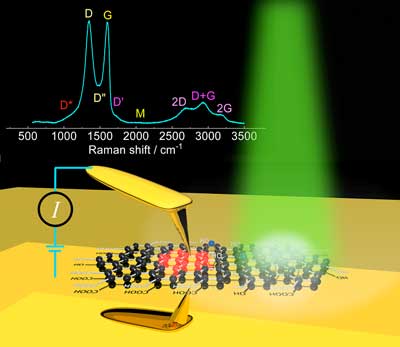| Jun 28, 2019 | |
Advanced method for analyzing graphene oxide(Nanowerk News) Researchers from Tomsk Polytechnic University have developed a reliable method for analyzing the reduction of graphene oxide microregions. In contrast to earlier proposed methods based on Raman spectroscopy, this advanced method provides more exact data about unique properties of certain areas of the material of only a few micrometers in size. |
|
| The paper on the research was published in the Physical Chemistry Chemical Physics journal ("The correlation between electrical conductivity and second-order Raman modes of laser-reduced graphene oxide"). | |
| The international research team led by Professor Raul Rodrigez from TPU School of Chemistry & Applied Biomedical Sciences and Professor Evgeniya Sheremet from TPU School of High Energy Physics is developing new field – optical nanospectroscopy, as well as plasmon and sensor materials development for biomedicine and electronics. | |
 |
|
| Raman spectrum of graphene oxide with the designation of peaks, and the scheme of the experiment. (Image: Tomsk Polytechnic University) | |
| According to Professor Sheremet, the study of unique physical-chemical properties of graphene oxide is still relevant despite many studies in the area. Graphene oxide has a graphene structure with attached oxygen-containing functional groups. The number of these groups strongly influences the properties of the material. | |
| ‘The fewer oxygen groups remain on the surface of graphene oxide, the higher its reduction. This criterion influences whether the material will be hydrophilic and a dielectric due to polar groups, or it will be more similar to graphene, i.e. hydrophobic and a conductor,’says Sheremet. | |
| There are several ways to evaluate the reduction, for example, X-ray photoelectron spectroscopy (XPS) and infrared spectroscopy. However, these methods work only with large areas of materials, whereas microregions are required to process graphene oxide to be applied in electronics. Therefore, TPU scientists investigate laser-reduced graphene oxide, the size of reduced areas can be less than several micrometers. | |
| ‘We were looking for a method that allowed us to obtain at least micron resolution, such as Raman spectroscopy,’ explains Evgeniya Sheremet. | |
| Reduced graphene oxide (rGO) was obtained under different laser powers in the range from 0.1 to 10 mW. Then, the researchers investigated reduced areas by using Raman spectrometer and a joint current sensing atomic force microscopy (CSAFM). Raman spectroscopy is widely used for the study of many properties of carbon materials, especially graphene, including mechanical stress, the number of defects, and the type of alloying. However, existing approaches suitable for graphene do not work for graphene oxide since its lattice has a greater number of defects. The analytical methods lose sensitivity in this case. | |
| ‘Usually, first-order peaks are analyzed in carbon materials but for graphene oxide, they do not provide reliable results. Therefore, we analyzed the areas of high frequencies and found a clear pattern. The relative intensity of second-order peaks decreases with increasing the extent of reduction. Notably, there is a strong correlation with the conductivity of the material, i.e. we can use Raman signal to assess the reduction of graphene oxide. This is a more reliable method than the earlier proposed ones,’ emphasizes Sheremet. | |
| Moreover, using nanospectroscopy approaches, this technique can be used for analyzing nanoscale areas. |
| Source: Tomsk Polytechnic University | |
|
Subscribe to a free copy of one of our daily Nanowerk Newsletter Email Digests with a compilation of all of the day's news. |
